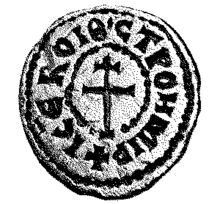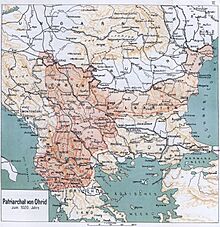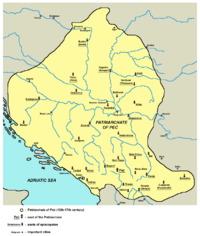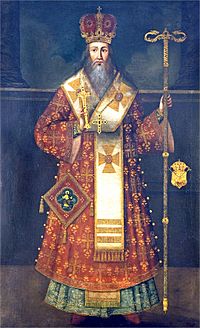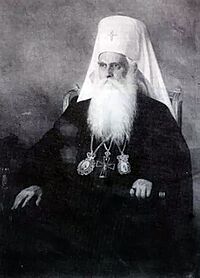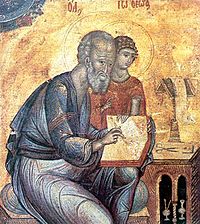Serbian Orthodox Church facts for kids
Quick facts for kids Serbian Orthodox Church |
|
|---|---|
| Српска православна црква Srpska pravoslavna crkva |
|
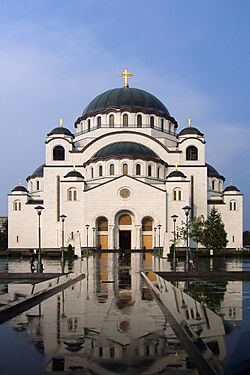
|
|
| Abbreviation | SOC, СПЦ, SPC |
| Type | Autocephaly |
| Classification | Christian |
| Orientation | Eastern Orthodox |
| Scripture | Septuagint, New Testament |
| Theology | Eastern Orthodox theology |
| Polity | Episcopal |
| Governance | Holy Synod of the Serbian Orthodox Church |
| Structure | Communion |
| Primate | Patriarch Porfirije |
| Bishops | 44 |
| Parishes | 3,100 |
| Associations | World Council of Churches |
| Language | Church Slavonic, Serbian |
| Liturgy | Byzantine Rite |
| Headquarters | Building of the Patriarchate, Belgrade; traditionally Patriarchate of Peć |
| Territory | Serbia, Bosnia and Herzegovina, Montenegro, Croatia, Kosovo, Slovenia Serbian diaspora: Europe(Germany, France, Spain, Belgium, Netherlands, Portugal, British Isles, Scandinavia, Romania, Bulgaria, Austria, Switzerland)America (Canada, United States of America, South America), Oceania (Australia, New Zealand) |
| Founder | Saint Sava |
| Origin | 1219 Kingdom of Serbia |
| Independence | 1219–1463 1557–1766 1879–present |
| Recognition | 1219 (Autocephalous archbishopric) 1346 (Autocephalous Patriarchate) 1557 (Autocephalous Patriarchate) 1879 (Autocephalous metropolis) 1920 (Autocephalous Patriarchate) |
| Separated from | Ecumenical Patriarchate of Constantinople |
| Separations | Macedonian Orthodox Church Montenegrin Orthodox Church Greek Catholic Church of Croatia and Serbia |
| Members | 8 to 12 million |
| Other name(s) |
|
The Serbian Orthodox Church (Serbian: Српска православна црква, Srpska pravoslavna crkva) is a major Christian church in Eastern Europe. It is one of the autocephalous (meaning self-governing or independent) Eastern Orthodox churches.
Most people in Serbia, Montenegro, and Republika Srpska (part of Bosnia and Herzegovina) are members of the Serbian Orthodox Church. It is organized into different areas called metropolitanates and eparchies (like dioceses). These are mainly found in Serbia, Bosnia and Herzegovina, Montenegro, and Croatia. There are also churches for Serbs living in other parts of the world, known as the Serb diaspora.
The leader of the Serbian Orthodox Church is called the Serbian Patriarch. He is seen as the "first among equals" among the church's bishops. The current Patriarch is Porfirije, who became leader on February 19, 2021.
The church became independent in 1219, thanks to Saint Sava. It was first known as the independent Archbishopric of Žiča. Later, in 1346, its status was raised to a patriarchate, and it was called the Serbian Patriarchate of Peć. This patriarchate was stopped by the Ottoman Empire in 1766. However, parts of the church continued to exist.
After Serbia became a principality again, the church regained its independence in 1831 and full self-governance in 1879. The modern Serbian Orthodox Church was re-established in 1920. This happened when several church regions, like the Metropolitanate of Belgrade, the Patriarchate of Karlovci, and the Metropolitanate of Montenegro, joined together.
Contents
- History of the Serbian Orthodox Church
- Who Belongs to the Church?
- How the Church is Organized
- Beliefs and Worship
- Art and Buildings
- Church Symbols
- See also
History of the Serbian Orthodox Church
Early Christian Beginnings
Christianity began to spread in southeastern Europe during the 1st century. Early Christian heroes, like Florus and Laurus, were killed for their faith in the 2nd century. Another important figure, Bishop Irenaeus of Sirmium, was also martyred in 304. Emperor Constantine the Great, who was born in Niš (modern Serbia), was the first Christian ruler of the Roman Empire.
In 395, the Roman Empire split into two parts. The eastern part became known as the Byzantine Empire. In 535, Emperor Justinian I created the Archbishopric of Justiniana Prima in his hometown. This church area covered many provinces. By the 7th century, invaders like the Avars and Slavs disrupted the church order. However, church life was renewed later in the same century as Serbs and other Slavs became more Christian.
How Serbs Became Christian
The early history of the Serbian Principality is written in a book called De Administrando Imperio. This book was put together by the Byzantine Emperor Constantine VII. It says that the Serbs received protection from Emperor Heraclius. The book also mentions that the Serbs were baptized from Rome around 632–638. This might have been for a small group of leaders at first.
From the 7th to the mid-9th century, the Serbs were influenced by the Roman Church. By the 870s, early medieval Serbs were considered Christian. However, the process of Christianization continued until the late 9th century. Even in the 13th century, some areas still showed that not everyone was fully Christian.
The Ecumenical Patriarchate of Constantinople (the main church in the East) began to spread its influence in the region around the mid-9th century. This happened as Byzantine emperors wanted church borders to match political borders. Emperor Basil I was very active in this. He likely sent a message to Mutimir of Serbia, who decided to keep the Serbian Church connected with Constantinople.
Christian names like Petar, Stefan, and Pavle started appearing among Serbian rulers in the 9th century. Prince Petar Gojniković (who ruled from 892–917) was clearly a Christian leader. Christianity was spreading during his time. When Bulgaria took over Serbia in 924, it was important for the future of the Serbian church. By then, Serbs likely started using the Cyrillic alphabet and Slavic religious texts.
The Ohrid Archbishopric (1018–1219)
After defeating the Bulgarian state in 1018, Emperor Basil II created the Archbishopric of Ohrid. He lowered the rank of the Bulgarian patriarchate to an archbishopric. This new archbishopric was still autocephalous (independent) from the Patriarchate of Constantinople. However, the emperor chose its leader from a list of candidates.
Basil II gave many special rights to this new church in 1020. In his documents, he mentioned the Bishopric of Serbia and the bishopric of Ras. The bishopric of Ras was located at the Church of the Holy Apostles Peter and Paul, Ras. It was part of the Bulgarian autocephalous church during the 10th and 11th centuries.
An old Slavic manuscript from the 10th or 11th century, called Codex Marianus, is one of the oldest known. It was partly written in the Serbian version of Old Church Slavonic. Other old writings include fragments from the 12th century.
Independent Archbishopric (1219–1346)
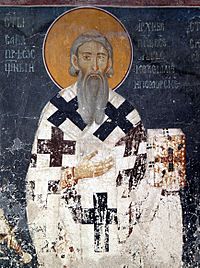
Rastko Nemanjić, a Serbian prince and son of Stefan Nemanja, became a monk named Sava in 1192. His father joined him later. They founded the Hilandar monastery on Mount Athos. This started a new period of growth in Serbian art, literature, and religion.
Saint Sava returned to Serbia in 1207. He brought his father's remains to the Studenica monastery. He also helped his two brothers, Stefan Nemanjić and Vukan, stop fighting. Stefan asked Sava to stay in Serbia and help the people. Sava built many churches and monasteries, including the Žiča monastery.
In 1217, Stefan became the King of Serbia. This led to questions about how the church should be organized. Saint Sava went back to Mount Athos in 1217/18 to prepare for an independent Serbian Church. In 1219, he was made the first Archbishop of the Serbian Church. He was given autocephaly (independence) by Patriarch Manuel I of Constantinople.
In the same year, Saint Sava published Zakonopravilo, a book of church laws. This gave Serbs both political and religious independence. Sava then appointed several bishops and sent them to organize church areas (dioceses) across Serbia. He also held a meeting in 1221 at the Žiča monastery to condemn the Bogomils, whom he considered heretics.
Saint Sava created several new church areas:
- Žiča, the main seat of the Archbishop.
- Eparchy of Zeta in the Zeta region.
- Eparchy of Hum in the Hum region.
- Eparchy of Dabar in the Dabar region.
- Eparchy of Moravica in the Moravica area.
- Eparchy of Budimlja in the Budimlja region.
- Eparchy of Toplica in the Toplica region.
- Eparchy of Hvosno in the Hvosno region.
Older church areas already under the Serbian Archbishop included:
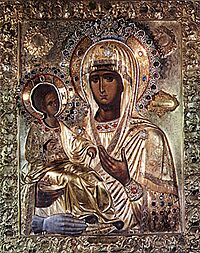
Saint Sava traveled to Palestine in 1229/1233. In Jerusalem, he met Patriarch Athanasios II. He visited holy places like Bethlehem and the Jordan River. He also bought two monasteries in the Holy Land for Serbian monks. The famous icon Trojerucica (Three-handed Theotokos) was given to Saint Sava. He later gave it to Hilandar.
Saint Sava died in Veliko Tarnovo, Bulgaria, on January 14, 1235. He was buried there, but his bones were later moved to the Mileševa monastery in southern Serbia on May 6, 1237.
In 1253, the main church seat was moved to the Monastery of Peć. The Serbian leaders moved between Žiča and Peć. The Žiča monastery was burned by the Cumans around 1276–1292. King Stefan Milutin rebuilt it. Important items from Žiča were moved to Peć. Other monasteries like Monastery of Gračanica and Monastery of Dečani were also built or renewed during this time.
The Medieval Patriarchate (1346–1463)

The Serbian Orthodox Church grew stronger as the Serbian kingdom expanded. When King Stefan Dušan became an emperor (tsar), the Serbian Archbishopric was also raised to the rank of a Patriarchate in 1346. In the next century, the Serbian Church became very powerful and respected.
On April 16, 1346, Stefan Dušan held a big meeting in Skopje. Church leaders from Serbia, Ohrid, Bulgaria, and Mount Athos were there. They all agreed to make the Serbian Archbishopric a Patriarchate. The Archbishop was now called the Serbian Patriarch. The main seat was at the Patriarchal Monastery of Peć. The new Patriarch, Joanikije II, then crowned Stefan Dušan as "Emperor and autocrat of Serbs and Romans." This change also meant that bishoprics became metropolitanates. The Patriarchate took control of Mount Athos and some Greek archbishoprics. This led to Dušan being excommunicated (kicked out of the church) by the Patriarch of Constantinople in 1350.
In 1375, the Serbian Patriarchate and the Patriarchate of Constantinople reached an agreement. The Battle of Kosovo in 1389 had a lasting impact on the Serbian Orthodox Church's history and traditions. In 1455, when the Ottoman Turks took over Peć, Patriarch Arsenije II found safety in Smederevo.
During this medieval period, the Serbian Orthodox Church supported the creation of many important cultural works. These included žitije (biographies) of rulers, archbishops, and saints.
Restored Patriarchate (1557–1766)
The Ottoman Empire conquered Serbian lands between 1459 and 1499. Many Serbs remained Christian, even though some converted to Islam. The church continued to exist, but it faced challenges. After Patriarch Arsenije II died in 1463, no new patriarch was chosen. The Patriarchate was effectively stopped, and the Serbian Church came under the control of the Archbishopric of Ohrid and then the Ecumenical Patriarchate.
The Serbian Patriarchate was finally restored in 1557. This happened thanks to pasha Mehmed Sokolović, who was of Serbian origin. His cousin, Makarije Sokolović, became the Patriarch in Peć. This restoration was very important for Serbs. It helped unite all Serbs in the Ottoman Empire spiritually.
During the time of Patriarch Jovan Kantul (1592–1614), the Ottoman Turks took the remains of Saint Sava from Mileševa monastery. They burned them on Vračar hill in Belgrade in 1594. This was done to scare the Serb people after revolts. The Temple of Saint Sava is now built on that very spot.
After several Serbian uprisings against the Turks, in which the church played a big role, the Ottomans abolished the Patriarchate again in 1766. The church once more came under the control of the Ecumenical Patriarch of Constantinople. This period was difficult for the church.
Church in the Habsburg Monarchy
During this time, Christians in the Balkans were pressured to convert to Islam. This was to avoid high taxes from the Turks. Many Serbs moved to the Habsburg monarchy to keep their Christian faith. There, they were granted some independence. In 1708, an independent Serbian Orthodox Metropolitanate of Karlovci was created. This later became a patriarchate (1848–1920).
Empress Maria Theresa (1740-1780) issued royal acts that set rules for the Serbian Orthodox Church in the Habsburg Monarchy. These rules covered how bishops were elected and how church areas were managed.
Modern History of the Church
The church was closely linked to Serbian efforts to resist Ottoman rule. This made Eastern Orthodoxy a key part of Serbian national identity. The Serbian Orthodox Church in the Principality of Serbia became independent in 1831. It was known as the Metropolitanate of Belgrade.
Serbia gained full political independence from the Ottoman Empire in 1878. Soon after, the Metropolitanate of Belgrade also gained full church independence (autocephaly) in 1879.
In Bosnia and Herzegovina, Serbian church areas remained under Constantinople. But after the Austro-Hungarian occupation in 1878, these areas gained some internal independence.
By the early 20th century, there were several separate Serbian church regions. These included the Patriarchate of Karlovci in the Habsburg monarchy, the Metropolitanate of Belgrade in Serbia, and the Metropolitanate of Montenegro in Montenegro.
During World War I (1914–1918), the Serbian Orthodox Church suffered many losses.
Reunification of the Church
After the liberation and political unification that created the Kingdom of Serbs, Croats and Slovenes in 1918, all Eastern Orthodox Serbs came together. All Serbian church regions joined to form a single Serbian Orthodox Church in 1920. The first leader of this united church was Serbian Patriarch Dimitrije (1920–1930).
The united church had a lot of influence in the Kingdom of Yugoslavia. It even worked against the government's plans to sign an agreement with the Holy See. The church also created new areas for Serbs living abroad. For example, a new area for the Czech lands was created in 1921. Another area for the United States and Canada was also formed.
During Second World War, the Serbian Orthodox Church faced severe challenges. It was persecuted by occupying powers and the Ustaše regime in Croatia. Many Serbs were killed, forced to leave, or forced to change their religion. Bishops and priests were especially targeted. Many churches were damaged or destroyed.
Under Communist Rule

After World War II, the church was controlled by the communist government of Josip Broz Tito. The government was suspicious of the church because of its past connections. The church, like other religious groups, was strictly controlled. Religious teaching was banned in schools, church property was taken, and religious activities were discouraged.
In 1963, the Serbian Church for Serbs living outside the country was reorganized. The church area for the United States and Canada was split into three. Some disagreements led to a separate "Free Serbian Orthodox Church" being formed. This split was healed in 1991.
The end of communism in Yugoslavia in the 1980s led to a rise in religious activity. Serbian Patriarch Pavle supported those who opposed Slobodan Milošević in the 1990s.
In 1967, the Macedonian Orthodox Church was created. This was part of a plan to build a Macedonian national identity. The Serbian Church did not recognize its independence. Similar plans for an independent church in Montenegro were considered. The Montenegrin Orthodox Church was proclaimed in 1993. However, it did not receive support from other Eastern Orthodox churches.
Recent History
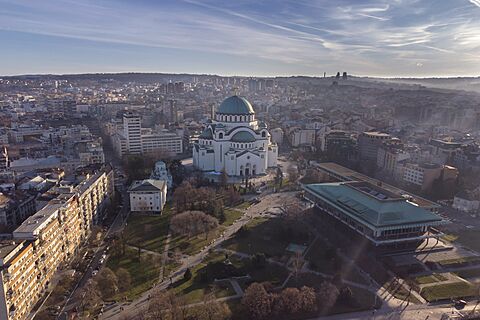
The Yugoslav wars in the 1990s greatly affected the Serbian Orthodox Church. Many churches in Croatia were damaged or destroyed during the war (1991–95). Bishops, priests, and many followers became refugees. Some church areas were almost completely empty after Serbs left Croatia in 1995.
Churches in Bosnia and Herzegovina were also affected. Many church buildings were destroyed or damaged. Many people from these areas also became refugees.

By 1998, the situation became more stable. Clergy and many followers returned. Most church property was back in use, and damaged buildings were being restored.
After the Kosovo War in 1999, many Serbian Orthodox holy sites in Kosovo were left with only clergy. Since June 1999, many Serbian Orthodox churches and monasteries have been damaged or destroyed. In 2004, 35 churches and monasteries were burned or destroyed by mobs. Thousands of Serbs were forced to move from Kosovo due to attacks on churches and Serbs.
The church areas for Serbs living abroad were fully reunited between 2009 and 2011. This brought full unity to Serbian church groups outside Serbia.
Who Belongs to the Church?
The Serbian Orthodox Church has more than 8 million members. These numbers come from official counts in countries where the church is present. Orthodoxy is the largest religion in Serbia, with over 5.3 million followers (81% of the population) in 2022. In Montenegro, it has around 320,000 members (51% of the population). It is the second-largest religion in Bosnia and Herzegovina (31.2%) and Croatia (4.4%). The number of members in other countries (like Western Europe, North America, and Australia) is not fully known. However, there are over two million Serbs living outside Serbia.
How the Church is Organized
The head of the Serbian Orthodox Church is the patriarch. He is also the leader of the church area called the Metropolitanate of Belgrade and Karlovci. The current patriarch is Porfirije. Serbian Orthodox patriarchs use the title His Holiness the Archbishop of Peć, Metropolitan of Belgrade and Karlovci, Serbian Patriarch.
The most important group in the Serbian Orthodox Church is the Bishops' Council. It includes the Patriarch, Metropolitans, Bishops, and Vicar Bishops. They meet once a year in spring. The Bishops' Council makes big decisions for the church and chooses the patriarch.
The Holy Synod is the church's executive body. It has five members: four bishops and the patriarch. The Holy Synod handles the daily operations of the church and meets regularly.

Church Areas
The Serbian Orthodox Church's territory is divided into:
- 1 main church area (patriarchal eparchy), led by the Serbian Patriarch.
- 4 special church areas called honorary metropolitanates, led by metropolitans.
- 35 regular eparchies (like dioceses), led by bishops.
These larger areas are further divided into smaller groups called deaneries. Each deanery has several church congregations or parishes. A parish is the smallest church unit. It is a group of Orthodox Christians who gather for worship with their local priest.
Orthodox Ohrid Archbishopric
The Orthodox Ohrid Archbishopric was an independent church area in North Macedonia. It was under the Serbian Orthodox Church. It was created in 2002 because it disagreed with the Macedonian Orthodox Church. It was dissolved in 2023. This archbishopric had one metropolitanate and six eparchies.
Beliefs and Worship
The Serbian Orthodox Church follows Eastern Orthodox theology. This is the same theology shared by all Eastern Orthodox Churches. It is based on the teachings from the Seven Ecumenical Councils. Key beliefs include believing in one God (the Trinity), the Incarnation of Jesus (God becoming human), and a focus on Sacred Tradition.
The church's worship practices are based on Eastern Orthodox worship. Services cannot be done by just one person; at least one other person must be present. Daily services are usually held only in monasteries and cathedrals. Local churches might only have services on weekends and major holidays. The Divine Liturgy is the main worship service where the Eucharist is celebrated.
A very important part of Serbian Orthodox tradition is the Slava. This is a celebration of a family's patron saint. Saint Sava, the first Serbian archbishop, added this tradition to the church.
Social Views
The Serbian Orthodox Church holds traditional views on social matters. This includes the idea of separation of church and state, which has been in place since 1945. It also has traditional views on social equality. Only men can become priests. The role of women in church leadership is limited to certain activities. These include religious education and religious art, as well as charity work.
Relations with Other Churches
The Serbian Orthodox Church is in full communion with the Ecumenical Patriarchate of Constantinople. This means they share the same beliefs and worship practices. It is also in communion with most other independent Eastern Orthodox churches, except for the Orthodox Church of Ukraine. The Serbian Orthodox Church has been a member of the World Council of Churches since 1965. Its patriarch, Patriarch German, was even elected to its central committee in 1968. It is also a member of the Conference of European Churches.
Art and Buildings
Church Architecture

Serbian medieval churches were built in the Byzantine style. The Raška style describes Serbian architecture from the 12th to the late 14th century. Examples include the monasteries of Studenica, Hilandar, and Žiča. The Vardar style developed in the late 13th century. It mixed Byzantine and Serbian influences to create a new style, seen in Gračanica and the Patriarchal Monastery of Peć.
As the Serbian Empire grew, it took over more land. This led to stronger influences from Byzantine art. The Morava style refers to churches built during the time Serbia was falling under Ottoman rule (1371 to 1459). Examples are Ravanica, Ljubostinja, Kalenić, and Resava.
In the 17th century, many Serbian Orthodox churches in Belgrade started to look like baroque churches. These were common in areas where Serbs lived under Habsburg rule. These churches often had a bell tower and a single nave. Their iconostasis (a screen with icons) was covered with Renaissance-style paintings. You can find these churches in Belgrade and Vojvodina.
Icons in the Church
Icons are special religious images. They are full of symbolism and mean much more than just showing a person. Because of this, Orthodox iconography (the art of making icons) is about carefully copying older icons. It's not usually about creating new artistic expressions. This was true until the 17th century, when Russian and Serbian icon painting started to be influenced by European religious art.
Large icons can be found on the walls of churches, often covering the entire inside. Orthodox homes also often have icons hanging on a wall, usually facing east. This is a central place where families can pray together.
Church Symbols
The official flag of the Serbian Orthodox Church is the Serbian tricolour (red, blue, and white) with a Serbian cross. This is stated in the church's constitution. Other unofficial flags also exist, sometimes with different crosses or symbols.
See also
 In Spanish: Iglesia ortodoxa serbia para niños
In Spanish: Iglesia ortodoxa serbia para niños
- List of heads of the Serbian Orthodox Church
- List of eparchies of the Serbian Orthodox Church
- List of Serbian Orthodox monasteries
- List of Serbian saints
- Timeline of the Serbian Orthodox Church
- Archive of the Serbian Orthodox Church


